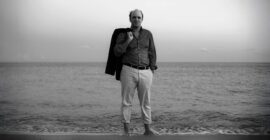The architectural practice K – studio was established by Dimitris and Konstantinos Karabatakis in 2002. Since then it has managed through a series of different type of projects, to set new design standards, within the Greek architectural scene. Its continuous experimentational approach has maintained the practice‘s distinguished individuality. We interviewed the two architects, in an attempt to decode some of the unique elements of their design identity.
The way you present your projects on your webpage brings to mind forms of manifesto, using short captivating phrases. Even graphically the way you use bold capital text on your images, recalls to Russian constructivist posters. Would you like to comment on this?
We study the brief of each project thoroughly and we try to reinterpret it. We always try to question the typology of each project by analysing its programmatic needs. The texts we present on our webpage are always quotes of the reinvented briefs. The statements for each type of project are parts of the ideas that formed the starting point of our design.
You like to use and mix elements from different architectural styles and periods. For example the housing complex Woodwing Villa(ge) you designed in Ekali, brings to mind, American post – war modernism. The summer house in Skiathos, through its horizontality and large spans reminds us of the summer house in Anavissos designed by Valsamakis, whereas the restaurant “Alemagou“ in Mykonos seems to aspire to traditional Cycladic architecture. What is your relation to architectural styles and how is this applied on your work?
We currently going through a contemporary – postmodern period, where architectural styles are substituted by programmatic designs. The aesthetics of a building, results from its programmatic needs. specific materials, building te-chniques and methods help to articulate the design of each project.
The use of light appears to be of vital importance in your designs, emphasizing the clean geometry of spaces, placed at the edge of walls or used as cuts in the ceiling. It strongly affects the schenography of each space, adding a theatrical dimension to each project. Is this a clear intention on your side?
We treat light as a material; either to emphasize a geometrical form or to define a specific area. Its ephemeral nature and ability to variate can transform a space, creating multiple atmospheres. When we design a shading canopy, we treat it as a filter. In the restaurants “Alemagou“ in Mykonos and “Bardouni“ in Costa Navarino, the canopies are designed to filter natural light rather than block it, creating a playful oscillation between light and shade.
The element of surprise is often found in your designs. You usually achieve this, through the use of folding or pulling elements (house in Kastri, Boxed – residence in Filothei). This stresses once again the theatrical aspect added on your spaces. One can say that you treat a living space as a stage set, awaiting for action to take place. Is theatricality a critical aspect of your design uniqueness?
We like to think that each space can be used in multiple ways, according to changing circumstances. Conse-quently, spatial flexibility has always been an aspect of our design approach. We like to question, and redefine boundaries. For example the way a set of spaces is connected or separated has always been a design challenge for us. Sometimes this is translated to a door opening while in other cases to the sliding of a whole wall.
The particular way you use materials is also another strong design feature of yours. For example, the way that wooden flooring can fold onto walls and ceiling in Filothei residence, or the ornamental way you pierced the metal screen in the Kastri apartment. This technique can also be found in the exhibition pavilion of Hellexpo and at Hama restaurant. In all these cases, the choice of material seems to be your starting point of design. Is that the case?
Materials and construction methods used define the character and atmosphere of each project and derive from the programmatic requirements. We always try to reevaluate the way we see certain materials and stress aspects of their nature. At the Capanna restaurant in Kolonaki, we reclaimed neoclassical style shutters to clad walls and ceiling, to lend the space a courtyard atmosphere.
Throughout your designs the narrative dimension of architecture is evident. One can say that your spaces have “a story to tell“. Do you believe that now-adays architecture is in need to go beyond a vessel of life, or should it just try to present itself as an attractive design product?
Architecture has the ability to frame and sustain life as well as to inspire and portray our aspirations. Architecture is a vessel of life with character! As Paul Shepheard said in his book “What is Archite-cture? Architecture is stones with character“.




